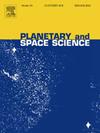High-resolution rock abundance derivation of lunar cold spot craters based on RA-SAR model
IF 1.7
4区 物理与天体物理
Q3 ASTRONOMY & ASTROPHYSICS
引用次数: 0
Abstract
The distribution of rock abundance (RA) on the lunar surface plays a pivotal role in understanding its geological evolution. This study focuses on the derivation of high-resolution RA data for lunar cold spot craters using Mini-RF (Miniature Radio Frequency) synthetic aperture radar (SAR) data. Firstly, terrain correction was applied to the SAR data. Secondly, the correlation between the Stokes parameters (, , , and ) and RA was examined using optically-derived RA data, which aligns with the resolution of the Mini-RF SAR images. By plotting scatter diagrams showing the relationships between the Stokes parameters and the optically-derived RA, strong statistical associations were established. Finally, based on these findings, we formulated a regression-based RA-SAR model. This model was applied to other lunar cold spot craters in order to derive their high-resolution RA distributions. The experimental results show that the model yields highly precise outcomes when validated against both Diviner RA and optical data. The study provides a new approach for inferring rock distribution across the lunar surface using SAR data, and offers valuable insights for advancing lunar geological research.
基于RA-SAR模型的月球冷斑陨石坑高分辨率岩石丰度推算
月球表面岩石丰度分布对了解月球地质演化具有重要意义。本研究主要利用Mini-RF (Miniature Radio Frequency)合成孔径雷达(SAR)数据推导月球冷斑陨石坑的高分辨率RA数据。首先,对SAR数据进行地形校正。其次,利用与Mini-RF SAR图像分辨率一致的光学衍生RA数据,研究Stokes参数(S1、S2、S3和S4)与RA之间的相关性。通过绘制散点图显示Stokes参数与光学衍生RA之间的关系,建立了很强的统计关联。最后,在此基础上,建立了基于回归的RA-SAR模型。该模型被应用于其他月球冷点陨石坑,以获得它们的高分辨率RA分布。实验结果表明,该模型对Diviner RA和光学数据进行了验证,结果精度很高。该研究为利用SAR数据推断月球表面岩石分布提供了一种新的方法,并为推进月球地质研究提供了有价值的见解。
本文章由计算机程序翻译,如有差异,请以英文原文为准。
求助全文
约1分钟内获得全文
求助全文
来源期刊

Planetary and Space Science
地学天文-天文与天体物理
CiteScore
5.40
自引率
4.20%
发文量
126
审稿时长
15 weeks
期刊介绍:
Planetary and Space Science publishes original articles as well as short communications (letters). Ground-based and space-borne instrumentation and laboratory simulation of solar system processes are included. The following fields of planetary and solar system research are covered:
• Celestial mechanics, including dynamical evolution of the solar system, gravitational captures and resonances, relativistic effects, tracking and dynamics
• Cosmochemistry and origin, including all aspects of the formation and initial physical and chemical evolution of the solar system
• Terrestrial planets and satellites, including the physics of the interiors, geology and morphology of the surfaces, tectonics, mineralogy and dating
• Outer planets and satellites, including formation and evolution, remote sensing at all wavelengths and in situ measurements
• Planetary atmospheres, including formation and evolution, circulation and meteorology, boundary layers, remote sensing and laboratory simulation
• Planetary magnetospheres and ionospheres, including origin of magnetic fields, magnetospheric plasma and radiation belts, and their interaction with the sun, the solar wind and satellites
• Small bodies, dust and rings, including asteroids, comets and zodiacal light and their interaction with the solar radiation and the solar wind
• Exobiology, including origin of life, detection of planetary ecosystems and pre-biological phenomena in the solar system and laboratory simulations
• Extrasolar systems, including the detection and/or the detectability of exoplanets and planetary systems, their formation and evolution, the physical and chemical properties of the exoplanets
• History of planetary and space research
 求助内容:
求助内容: 应助结果提醒方式:
应助结果提醒方式:


